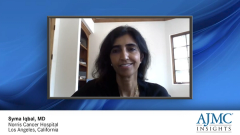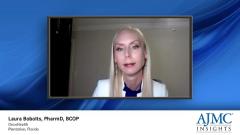
Determining Individual Treatment Sequencing for Patients with Gastroesophageal Cancer
Dr Cleary outlines strategies to individualize care for patients diagnosed with upper GI and esophageal cancer.
Episodes in this series

James M. Cleary, MD, PhD: I’m very happy to say that biomarker testing is incredibly relevant in the treatment of gastroesophageal cancers. It has exploded over the last few years. We can use genomic information and proteomic information to select which treatments work best for our patients. The important things to test in our patients with gastroesophageal cancer include seeing whether the patient has an MSI [microsatellite instability]–high tumor. MSI-high tumors are really sensitive to PD-1–directed therapy. You also want to test to see if the tumor is HER2 [human epidermal growth factor receptor 2] amplified. Because if the tumor is HER2 amplified, there’s HER2-targeted therapy that has worked very well in gastroesophageal cancer, and you really want to get those patients on those agents.
The other thing is looking at PD-L1 status. PD-L1 status is really important in trying to get a sense of how likely immunotherapy is to work, especially when you’re thinking about using first-line PD-1–directed therapy combined with chemotherapy. The evidence is best when PD-L1 standing in a tumor by CPS [combined positive score] is 5 or greater. The entire oncology community agrees that’s where you should give FOLFOX [5-fluorouracil, leucovorin, oxaliplatin]–nivolumab. When PD-L1 CPS is less than 5, it’s more gray. The outcomes and the effectiveness of PD-1–directed therapy goes down. If I have a patient in the first-line setting with a PD-L1 score between 1 and 5, I give nivolumab along with FOLFOX. When the PD-L1 score is 0, I have a long conversation with the patient, and oftentimes I don’t give it.
Next-generation sequencing can also tell you that occasionally you’ll see a patient with a very high TMB, or tumor mutational burden, and that also tells you that you should be using PD-1–directed therapy. It could also tell you other types of molecular changes. It can tell you very rare things, such as NTRK translocations, and that there are approved drugs for that indication. With next-generation sequencing, you can get HER2 amplification status, you can see whether the tumor is MSI high, and you can see the TMB and other genetic alterations. That’s very important clinically.
In the second-line setting, I always want to assess the patient’s performance status. That’s the first thing you’re asking. Is this a patient who can still get systemic chemotherapy? The second thing I want to assess is what the biomarkers look like. If it’s HER2 amplified, I have very different treatments compared with if it isn’t HER2 amplified. The third thing I want to look at is whether the patient just got off chemotherapy. That’s most of the patients. Most of the time, patients will be getting FOLFOX [5-fluorouracil, leucovorin, oxaliplatin]–nivolumab in the first-line setting, and eventually, a scan shows progression. I switch those patients to paclitaxel or ramucirumab if they have a good performance status. If for some reason the patient got FOLFOX [5-fluorouracil, leucovorin, oxaliplatin] and there was a big treatment holiday, and then 6 or 7 months later the patient progressed, I might think about using something like FOLFIRI [5-fluorouracil, leucovorin, irinotecan] combination chemotherapy because the patient hasn’t gotten that much chemotherapy in the past.
Transcript edited for clarity.
Newsletter
Stay ahead of policy, cost, and value—subscribe to AJMC for expert insights at the intersection of clinical care and health economics.
































































